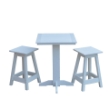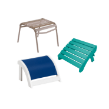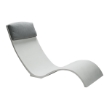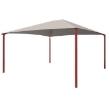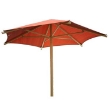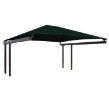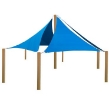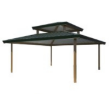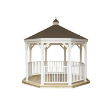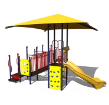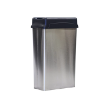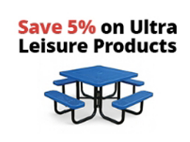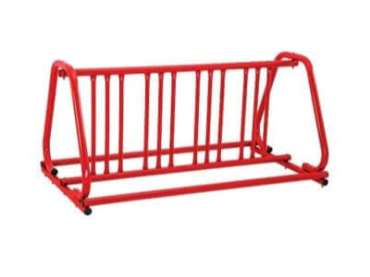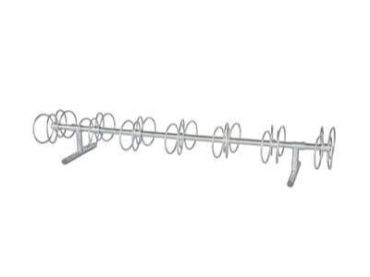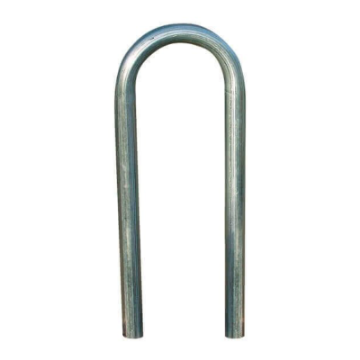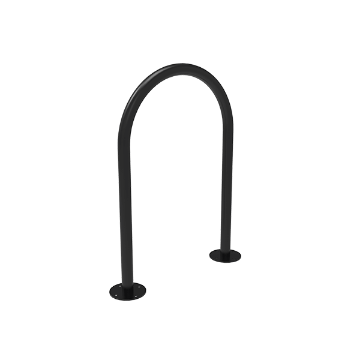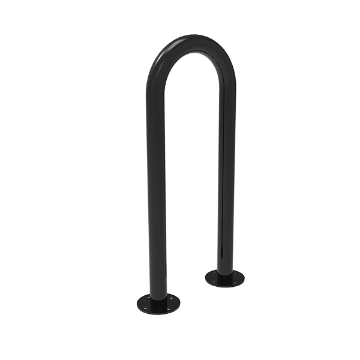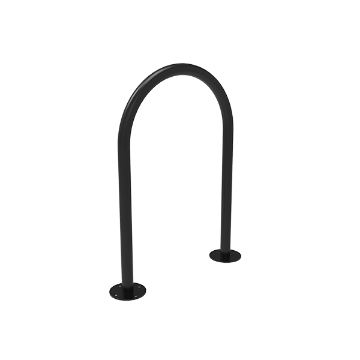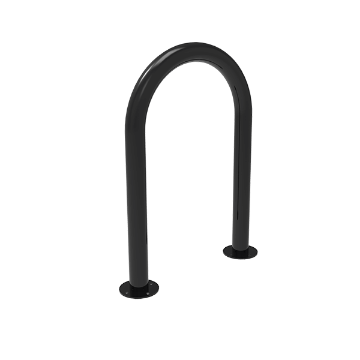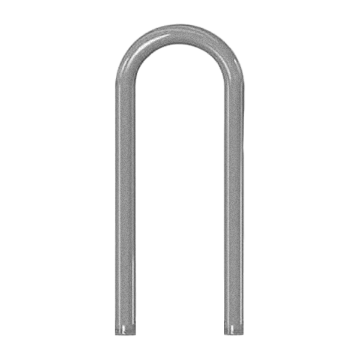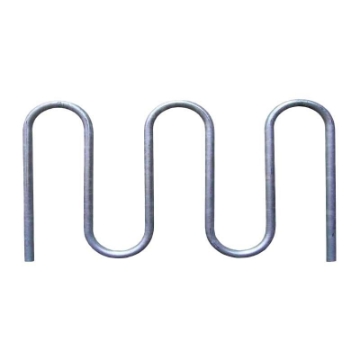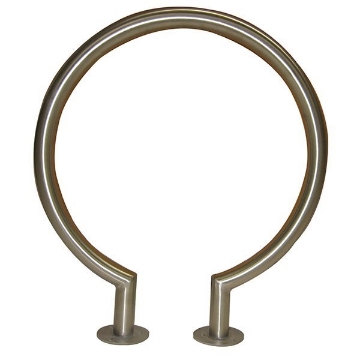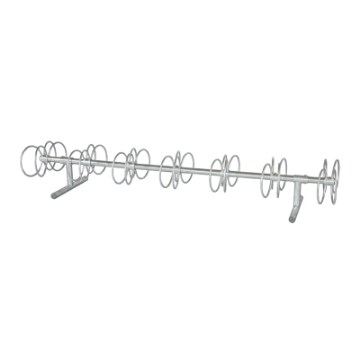Commercial Bike Racks
Whether you manage an office building, apartment complex, retail center, school, park, or other public space, providing quality bike racks demonstrates your commitment to sustainability and convenience for cyclists. Investing in commercial-grade racks ensures secure parking options tailored to your location, protecting bikes from theft while encouraging eco-friendly transportation. Furniture Leisure offers durable, high-quality bike parking racks in a variety of styles, sizes, and materials, so you're sure to find racks to suit your visitors' needs. Choose from our loop, grid, circle, low profile, and custom bike racks.
ELITE 1 Hump - 3 Bike Steel Wave Rack - 2 3/8” Polyethylene Coated Tube Frame - Quick Ship
ELITE 1 Hump - 3 Bike Steel Wave Rack - 2 7/8” Polyethylene Coated Tube Frame - Quick Ship
RHINO Coated 1 Hump - 3 Bike Steel Wave Rack - 1.90" Tube, Inground or Surface Mount
- 1
- 2
Commercial Bike Racks - Keeps bicycles safe and organized
Commercial-grade bike racks are used in public places to keep bicycles safe from theft and organize them in one location. They are usually made from galvanized steel to resist rust and corrosion and come in many styles and shapes. Many are powder-coated, but some even have an epoxy coating for durability. Bike racks are also made from wood, recycled plastic, concrete, and more.
There are two-sided racks called “A-Frame” or “J-Frame” due to the shape of their supporting structure. At Furniture Leisure, we also sell circle frames and low-profile racks that take up less space. Thanks to industry and technology developments, manufacturers can make creative loop styles that are more artistic and pleasing to the eye.
Due to rising fuel costs in the US, we anticipate an increase in demand for secure bike parking racks as people make efforts to reduce their dependence on gas. This will be a long-term trend, as people will find that biking is a more affordable option that also helps them stay active. Bike racks can be found at most public buildings and many private properties, such as convenience stores, libraries, shopping malls, schools, parks, office buildings, apartment complexes, and restaurants.
Bike Rack Mounting Options
When selecting commercial bike racks, you first need to determine the right mounting options for your space and usage requirements. The three main mounting methods include:
Freestanding Racks
Freestanding racks provide flexible placement options since they don't require mounting to walls or the ground. They come in various materials like stainless steel, recycled plastic, and galvanized steel. These racks work well in open areas and can accommodate U-locks. However, they don't provide as much security as mounted options.
In-Ground Mounted Racks
In-ground racks are permanently installed into concrete or asphalt. While less adaptable, they offer sturdy security and high-capacity parking. Popular choices include the "post and ring" and "staple" bike racks.
Surface Mounted Racks
Surface-mounted racks attach to existing hardscapes like concrete or asphalt using bolt-down connections. They offer security without excavation work. Surface mounts come in curved, wave, and arc shapes to maximize parking.
Commercial Bike Rack Styles
Commercial-grade bike racks come in many varieties to suit the space they occupy and meet visitors' needs. Here are some common types of bike racks:
- Loop Bike Racks: These feature a continuous looped ring or oval shape that allows two bikes per loop. Loops can be a single ring or a helix coil design. They maximize capacity in small footprints.
- Grid Bike Racks: This is the most typical design for a commercial bike rack, featuring several sturdy vertical bars in a row. Grids maximize parking capacity while keeping bikes upright and accessible. They work well in high-traffic areas.
- Circle Bike Racks: As the name suggests, these use rings to hold bikes upright. Each set of rings holds one, providing lots of space between bikes.
- Low Profile Racks: Low-profile bike racks are a great space-saving solution. They hold bikes by the front wheels or frame.
- Custom Racks: Bespoke racks are designed for unique spaces or branding needs. Customization allows specialized security, capacity, and aesthetics.
The Benefits of a Commercial Bike Rack
Commercial-grade bike racks provide numerous benefits, from convenience and aesthetics to security and sustainability. Low-profile bike racks, for example, offer a subtle but functional design, making them much more than just a bicycle stand. They seamlessly fit into park settings and give cyclists a secure place to park their bikes while enjoying nature.
Another major perk of commercial bike racks is their versatility. Designs can range from bollard-style bike racks, suitable for smaller spaces, to grid bike racks, allowing for different mounting options. A wave bike rack, for example, is both artistic and practical with its ability to accommodate several bikes at the same time.
Commercial-grade bike racks can be very durable when built with the right materials. A stainless steel constructed bike rack is robust and stands up well to various weather conditions, making it a great choice for outdoor bike racks. The option for a powder-coated bike rack provides an extra layer of protection, further enhancing its durability and maintaining its aesthetic appeal over time.
The bicycle infrastructure in a city or a private establishment speaks volumes about its concerns for environmental sustainability, public health, and cyclist safety. Commercial-grade bike racks send a clear message of inclusivity and commitment to these important community values.
Key Features of Quality Commercial Bike Racks
Well-designed bike racks have features to protect your investment and make parking safe and easy. Look for these characteristics:
- Durable materials: Metal compositions like stainless steel resist rust and corrosion. Coatings add extra weather protection. Avoid cheaper racks that easily bend or warp.
- Allows U-lock use: Security is maximized when bikes can be locked through the frame. Racks with open designs allow U-locks to capture both the rack and bike.
- Organized parking: Ample space between racks prevents handlebar entanglement and bike damage. Layouts for orderly parking also make retrieval easier.
- ADA compliance: Your racks must meet accessibility standards per the Americans with Disabilities Act. ADA-compatible designs are low enough for disabled users to reach and provide adequate space.
Investing in racks with professional quality design ensures proper use and protects bikes from damage.
Factors to Consider When Choosing a Commercial Bike Rack
Bike racks encompass a range of designs from functional to stylish, including bollard-style bike racks, custom bike racks, and wave bike racks. The sheer variety of styles available can seem overwhelming. The key is to find a balance between aesthetics, capacity, durability, and cost.
- Aesthetics: Racks should blend into or enhance your property's visual identity. Materials like stainless steel, aluminum, or recycled plastic provide attractive, eco-friendly choices.
- Capacity: Consider the number of cyclists needing parking now and in the future. Optimize density with staggered or double-sided racks. Allow ample clearance between bikes.
- Durability: Racks should withstand constant locking pressure and environmental exposure. Prioritize commercial-grade over consumer racks. Look for tamper-proof mountings.
- Security: Racks that fully support bike frames deter theft better than wheel locks. Allow U-lock use. Place racks in visible locations. Sturdy mounting prevents removal.
- Cost: Budget commercial-grade racks offer similar security to premium ones for less, but avoid racks that compromise quality and longevity to save money.
- Special Needs: ADA-compliant racks accommodate disabled users. Sheltered racks protect bikes. Custom racks address unique spaces.
Thoughtfully weighing these key factors will guide you to the ideal bike racks for your property's specific requirements.
Bike Rack Capacity Guidelines
To find the right amount of parking, you’ll need to estimate demand. As a general rule, allow 3% of building capacity for bike parking as a starting benchmark. For example, a 100-person office would plan for 3 spaces. Consider if your building has high bike commuting potential based on location, building use, and local cycling rates.
For large properties, a bike parking study is recommended to assess specific usage. You can conduct periodic counts during peak parking times to get real data. Observe fill rates to determine if more racks are needed or if underused racks can be removed or relocated.
Bike Rack Placement Guidelines
Proper bike rack placement is critical for usage, security, and accessibility. Keep these tips in mind when choosing a location for bike racks:
- Locate racks in visible locations with ample lighting to deter theft. Close proximity to building entryways also enhances convenience.
- Allow sufficient clearance around racks so bikes don’t encroach on walkways or vehicle parking. Avoid close proximity to construction zones or delivery areas.
- If possible, provide sheltered parking, which protects bikes from rain and provides shade. Options include bike cages, covered arcades, or indoor parking areas.
Taking time to find optimal rack locations makes cycling an easy choice for employees and visitors.
Installing In-Ground Commercial Bike Racks
In-ground mounted racks require proper installation to keep them stable and safe for long-term use. Here is some advice for installation:
- Choose a flat installation surface — asphalt or concrete is best. Avoid loose or uneven surfaces.
- Use manufacturer specs for sizing the concrete footing. A typical 2-bike rack may require a footing of 24” x 24” x 36”.
- The footing must extend below the frost line to prevent shifting during ground freezing. The depth varies by region.
- Orient racks so spacing requirements are met between racks as well as adjacent obstructions.
- Use a concrete anchor bolt to secure the rack. Some models include theft-resistant fasteners.
- Allow the concrete to fully cure before use, which takes approximately 7 days.
The correct installation provides a stable foundation to withstand constant bike locking pressure and environmental factors.
Maintaining Commercial Bike Racks
Bike racks require periodic inspection and maintenance to maximize their lifespan:
- Periodically inspect racks for damage from use or vandalism. Spot paint any scratches or rust.
- Ensure all hardware remains securely fastened. Replace missing nuts and bolts.
- Assess signage and markings around racks. Refresh any faded paint and reminders.
- Verify racks remain securely anchored.
- Review usage levels and rearrange racks if certain areas become over/underutilized.
- Update racks if newer designs provide better security, capacity, or ease of use.
Proper care preserves the functionality and longevity of your bike racks.
Furniture Leisure Commercial Bike Racks
Show your commitment to sustainability and a healthy community by investing in high-quality bike racks from Furniture Leisure. Our commercial bike racks deliver functionality, security, durability, and aesthetics. Contact us today for a custom quote tailored to your property needs and budget.
FAQs
How much weight can commercial bike racks hold?
Quality commercial racks are designed to hold over 100 lbs per bike space. Optimal designs fully support the frame, not just the wheels, to prevent tipping accidents. Prioritize racks rated for public/commercial use over consumer grades.
How far should bike racks be placed from walls and curbs?
Allow a minimum clearance of 36 inches from walls and curbs to accommodate handlebar widths. A greater distance (48+ inches) makes parking even easier. Avoid placing racks too close together, which can lead to tangled handlebars and damaged bikes.
What are the best materials for outdoor bike racks?
Outdoor racks are subject to rain, snow, and sunlight. Stainless steel is very durable but can be on the more costly side. More affordable options include galvanized steel or steel with weather-resistant powder coatings. Plastic and powder coatings add protection against corrosion, so avoid uncoated steel.
Should bike racks be covered?
Covered racks protect bikes from rain and provide shade from the sun. Simple covers include overhangs, awnings, pergolas, and trees. Fully enclosed options like bike cages or special shelters offer comprehensive protection. If uncovered, locate racks where building eaves or trees offer some protection.
Related Searches:
Loop Bike Racks, Grid Bike Racks, A Frame Bike Racks, J Frame Bike Racks, W Frame Bike Racks, Circle Bike Racks, Low Profile Bike Racks, Custom Bike Racks, Picnic Tables, ADA Picnic Tables, Park Benches, Trash Cans, Pet Waste Stations, Stadium Bleachers


















